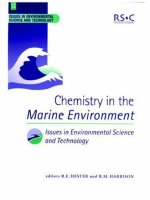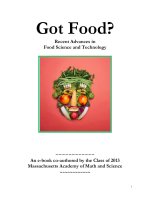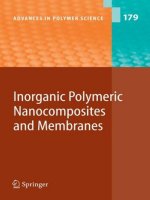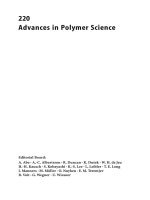ADVANCES IN BIOMATERIALS SCIENCE AND BIOMEDICAL APPLICATIONS_1 pptx
Bạn đang xem bản rút gọn của tài liệu. Xem và tải ngay bản đầy đủ của tài liệu tại đây (17.39 MB, 302 trang )
ADVANCES IN
BIOMATERIALS SCIENCE
AND BIOMEDICAL
APPLICATIONS
Edited by Rosario Pignatello
Advances in Biomaterials Science and Biomedical Applications
/>Edited by Rosario Pignatello
Contributors
Chowdhury, Xiaohong Wang, Irene Tereshko, Valery Tereshko, Patrick Frayssinet, Ben Ayed Foued, Shaojun Yuan,
Gordon Xiong, Ariel Roguin, Swee Hin Teoh, Cleo Choong, Tiago Pereira, Andrea Gartner, Paulo Armada-Da-Silva,
Cátia Pereira, Miguel França, Diana Morais, Miguel Rodrigues, Ascenção Lopes, José Domingos, Ana Lúcia Luís, Ana
Colette Maurício, Irina Amorim, Raquel Gomes, Xiongbiao Chen, Mituso Niinomi, Ylenia Zambito, Masaru Murata,
Young-Kyun Kim, Kyung-Wook Kim, Jeong Keun Lee, In-Woong Um, Stefano Geuna, Frank Xue Jiang, Yan-Ru Lou,
Carmen Escobedo-Lucea, Arto Urtti, Marjo Yliperttula, Juan Valerio Cauich-Rodríguez, Juliana Carvalho, Mhamdi Lotfi,
M. Nejib, M. Naceur, Lucie Germain, Jean-Michel Bourget, Maxime Guillemette, Teodor Veres, François A. Auger,
Ruggero Bettini, Susan Scholes, Thomas Joyce
Published by InTech
Janeza Trdine 9, 51000 Rijeka, Croatia
Copyright © 2013 InTech
All chapters are Open Access distributed under the Creative Commons Attribution 3.0 license, which allows users to
download, copy and build upon published articles even for commercial purposes, as long as the author and publisher
are properly credited, which ensures maximum dissemination and a wider impact of our publications. However, users
who aim to disseminate and distribute copies of this book as a whole must not seek monetary compensation for such
service (excluded InTech representatives and agreed collaborations). After this work has been published by InTech,
authors have the right to republish it, in whole or part, in any publication of which they are the author, and to make
other personal use of the work. Any republication, referencing or personal use of the work must explicitly identify the
original source.
Notice
Statements and opinions expressed in the chapters are these of the individual contributors and not necessarily those
of the editors or publisher. No responsibility is accepted for the accuracy of information contained in the published
chapters. The publisher assumes no responsibility for any damage or injury to persons or property arising out of the
use of any materials, instructions, methods or ideas contained in the book.
Publishing Process Manager Oliver Kurelic
Technical Editor InTech DTP team
Cover InTech Design team
First published April, 2013
Printed in Croatia
A free online edition of this book is available at www.intechopen.com
Additional hard copies can be obtained from
Advances in Biomaterials Science and Biomedical Applications, Edited by Rosario Pignatello
p. cm.
ISBN 978-953-51-1051-4
free online editions of InTech
Books and Journals can be found at
www.intechopen.com
Contents
Preface IX
Section 1 Characterization of Novel Biomaterials 1
Chapter 1 Biomedical Applications of Materials Processed in Glow
Discharge Plasma 3
V. Tereshko, A. Gorchakov, I. Tereshko, V. Abidzina and V. Red’ko
Chapter 2 Mechanical Properties of Biomaterials Based on Calcium
Phosphates and Bioinert Oxides for Applications in
Biomedicine 23
Siwar Sakka, Jamel Bouaziz and Foued Ben Ayed
Chapter 3 Degradation of Polyurethanes for Cardiovascular
Applications 51
Juan V. Cauich-Rodríguez, Lerma H. Chan-Chan, Fernando
Hernandez-Sánchez and José M. Cervantes-Uc
Chapter 4 Substrates with Changing Properties for Extracellular
Matrix Mimicry 83
Frank Xue Jiang
Section 2 Biocompatibility Studies 109
Chapter 5 Overview on Biocompatibilities of Implantable
Biomaterials 111
Xiaohong Wang
Chapter 6 In Vitro Blood Compatibility of Novel Hydrophilic Chitosan
Films for Vessel Regeneration and Repair 157
Antonello A. Romani, Luigi Ippolito, Federica Riccardi, Silvia
Pipitone, Marina Morganti, Maria Cristina Baroni, Angelo F.
Borghetti and Ruggero Bettini
Chapter 7 Amelioration of Blood Compatibility and Endothelialization of
Polycaprolactone Substrates by Surface-Initiated Atom Transfer
Radical Polymerization 177
Shaojun Yuan, Gordon Xiong, Ariel Roguin, Swee Hin Teoh and
Cleo Choong
Chapter 8 Cell Adhesion to Biomaterials: Concept of
Biocompatibility 207
M. Lotfi, M. Nejib and M. Naceur
Section 3 Drug and Gene Delivery 241
Chapter 9 Nanoparticles Based on Chitosan Derivatives 243
Ylenia Zambito
Chapter 10 pH-Sensitive Nanocrystals of Carbonate Apatite- a Powerful
and Versatile Tool for Efficient Delivery of Genetic Materials to
Mammalian Cells 265
Ezharul Hoque Chowdhury
Section 4 Biomaterials for Tissue Engineering and Regeneration 293
Chapter 11 Innovative Strategies for Tissue Engineering 295
Juliana Lott Carvalho, Pablo Herthel de Carvalho, Dawidson Assis
Gomes and Alfredo Miranda de Goes
Chapter 12 Biofabrication of Tissue Scaffolds 315
Ning Zhu and Xiongbiao Chen
Chapter 13 Biomaterials and Stem Cell Therapies for Injuries Associated to
Skeletal Muscular Tissues 329
Tiago Pereira, Andrea Gärtner, Irina Amorim, Paulo Armada-da-
Silva, Raquel Gomes, Cátia Pereira, Miguel L. França, Diana M.
Morais, Miguel A. Rodrigues, Maria A. Lopes, José D. Santos, Ana
Lúcia Luís and Ana Colette Maurício
Chapter 14 Alignment of Cells and Extracellular Matrix Within Tissue-
Engineered Substitutes 365
Jean-Michel Bourget, Maxime Guillemette, Teodor Veres, François
A. Auger and Lucie Germain
ContentsVI
Chapter 15 Autograft of Dentin Materials for Bone Regeneration 391
Masaru Murata, Toshiyuki Akazawa, Masaharu Mitsugi, Md Arafat
Kabir, In-Woong Um, Yasuhito Minamida, Kyung-Wook Kim,
Young-Kyun Kim, Yao Sun and Chunlin Qin
Chapter 16 Healing Mechanism and Clinical Application of Autogenous
Tooth Bone Graft Material 405
Young-Kyun Kim, Jeong Keun Lee, Kyung-Wook Kim, In-Woong
Um and Masaru Murata
Chapter 17 The Integrations of Biomaterials and Rapid Prototyping
Techniques for Intelligent Manufacturing of
Complex Organs 437
Xiaohong Wang, Jukka Tuomi, Antti A. Mäkitie, Kaija-Stiina
Paloheimo, Jouni Partanen and Marjo Yliperttula
Chapter 18 Mesenchymal Stem Cells from Extra-Embryonic Tissues for
Tissue Engineering – Regeneration of the
Peripheral Nerve 465
Andrea Gärtner, Tiago Pereira, Raquel Gomes, Ana Lúcia Luís,
Miguel Lacueva França, Stefano Geuna, Paulo Armada-da-Silva and
Ana Colette Maurício
Section 5 Special Applications of Biomaterials 499
Chapter 19 Hydroxylapatite (HA) Powder for Autovaccination Against
Canine Non Hodgkin’s Lymphoma 501
Michel Simonet, Nicole Rouquet and Patrick Frayssinet
Chapter 20 Dental Materials 515
Junko Hieda, Mitsuo Niinomi, Masaaki Nakai and Ken Cho
Chapter 21 Ceramic-On-Ceramic Joints: A Suitable Alternative Material
Combination? 539
Susan C. Scholes and Thomas J. Joyce
Contents VII
Preface
A recent editorial production from InTech resulted in the publication of three volumes focused
on biomaterials. In those books, also edited by myself, the fundamental and applicative aspects
of biomaterials, in the wide connotation of the word, have been reviewed and supported by the
experimental work of many scientists, who from many years have dedicated their research to
this fascinating world, composed of many different skills, techniques and competencies.
When I was invited by the Publisher to coordinate a further editorial task on Biomaterials, I
was glad to help in collecting new contributions in this area of research and science. The scien‐
tific production in the field is, in fact, rapidly growing and updating, mainly on the fronts of
new and original applications of already known or novel compounds and polymers. As proof,
we easily received a high number of articles to be selected for composition of this new volume.
The chosen title gives a clear suggestion to the need of focusing all the basic studies, for in‐
stance the physico-chemical characterization of biomaterials, towards their potential applica‐
tions in biomedicine and drug delivery, or in any other relevant area of diagnosis, therapy,
surgical manipulation, and rehabilitation. Traditional, or ‘known’, biomaterials can now be
handled to meet specific medical needs, based on the large experience of their chemical, physi‐
cal and biological properties. Conversely, newly produced materials can be directly designed
and tailored to such requirements, so that novel and somewhat unexpected areas of applica‐
tion are continuously disclosed.
These considerations have been the basis of this editorial product. The contribution presented
consists of review articles, original researches and experimental reports from eminent interna‐
tional experts of the multidisciplinary world, which is required for an effective development
and utility of biomaterials. 21 chapters have been organized to explore different aspects of bio‐
materials science. From advanced means for the characterization and toxicological assessment
of new materials, passing through some ‘classical’ applications in nanotechnology and tissue
engineering, toward novel specific uses of these products, the volume is intended to give read‐
ers a view of the wide range of disciplines and methodologies that
have been exploited to de‐
velop biomaterials with the physical and biological features needed for specific clinical and
medical purposes.
I hope that you reading these interesting chapters will prompt your interest research towards
the exciting field of biomaterials science and applications
Rosario Pignatello
Universita degli Studi di Catania, Italy
Section 1
Characterization of Novel Biomaterials
Chapter 1
Biomedical Applications of
Materials Processed in Glow Discharge Plasma
V. Tereshko, A. Gorchakov, I. Tereshko,
V. Abidzina and V. Red’ko
Additional information is available at the end of the chapter
/>1. Introduction
There is exhaustive literature about interactions of charged particles with solid surfaces [l, 2].
For a long period only high energies were assumed to cause any significant modifications.
However, low-energy ion bombardments (up to 5 keV) of metal and alloy samples were shown
to be very efficient too: the increase of dislocation density (up to 10 mm in depth from the
irradiated surface) was detected [3–7]. In fact, a bulk long-range modification of materials in
the glow discharge plasma (GDP) took place. The above results were obtained by the use of
transmission electron microscopy for well annealed samples with initially small dislocation
density (armco-Fe, Ni3Fe, etc.) [4, 6]. For materials with initially increased dislocation density
(unannealed copper, M2 high-speed steel, titanium alloys) reorganization of dislocation
structure is the most considerable: either intensive formation of the dislocation fragments or
grinding of the fragments with corresponding increase in their disorientation is observed.
These reorganizations also take place well below the irradiated surface. When the ion energy
decreases by 1 keV, the modified layer became even deeper [7].
The above results can only be explained by taking the nonlinear nature of atom interactions
into account. The ion bombardment is assumed to induce nonlinear oscillations in crystal
lattices leading to self-organization of the latter. Modelling shows the formation of new
collective atom states. The observed phenomena include the redistribution of energy, cluste‐
rization, structure formation when the atoms stabilizes in new non-equilibrium positions,
localized structures, auto-oscillations, and travelling waves and pulses [3–7].
The next step was to look at the influence of low-energy GDP on liquids. Water that
occupies up 70 percent of the Earth's surface and is the main component of all living things
© 2013 Tereshko et al.; licensee InTech. This is an open access article distributed under the terms of the
Creative Commons Attribution License ( which permits
unrestricted use, distribution, and reproduction in any medium, provided the original work is properly cited.
was taken for investigation. Water molecules are able to create molecular associates using
Van der Waals forces as well as labile hydrogen interactions [8–11]. Owing to hydrogen
bonds molecules of water are capable to form not only random associates (one having no
ordered structure) but clusters, i.e. associates having some ordered structure [9–11]. The
network of hydrogen bonds and the high order of intermolecular cooperativity facilitate
long-range propagation of molecular excitations [12, 13]. This allows, in principle, to
consider water and water-based solutions as systems sensitive to weak external forces.
Indeed, the study of luminescence at long time scale shows that the structural equilibri‐
um in water is not stable: it changes after dissolution of small portions of added substan‐
ces and after exposition of aqueous samples to UV and mild X-ray irradiation [14].
The results obtained by Lobyshev, et al opened up the new avenues to water and aqueous
solutions as non-equilibrium systems capable of self-organization [14]. The key property of
self-organization is, however, nonlinearity to which, in models of water, hasn’t paid the
required attention yet. The present paper is aimed to cover this flaw. Basic models of nonlinear
chains that can be related to water structure were investigated. We observed self-organization
processes resulting in the displacement of atoms and their stabilization in new positions, which
can be viewed as the formation of water clusters.
In experiments, we exposed crop seeds, baking yeast and water to GDP. The results were very
promising: the seed sprouts showed greater growth and the yeast showed greater metabolic
activity compared to the control samples. The results on volunteers with different diseases,
who either drunk the processed water or was injected intravenously with the processed
physiological solution, were encouraging too. The diagnostics of volunteers’ blood immune
cells (lymphocytes and leukocytes) showed significant normalization of their state toward
homeostasis.
Next part of this paper is devoted to the study of properties of implants processed in GDP.
The modern medicine is characterized by active introduction of high technologies to clinical
practice. It requires sufficient biocompatibility of implanted mechanical, electromechani‐
cal and electronic devices with natural tissues. The properties of materials are crucial, since
insufficient biocompatibility can lead to the negative reactions to the implant from the side
of surrounding tissues causing inflammatory processes, dysfunction of the endothelium,
disturbance of homeostasis, destruction and the necrosis of bone tissue and so forth [15,
16]. The formation of hydrophilic coatings and the modification of chemical composition
and topography of the implant surface make it possible to reduce the frequency of the
development of negative processes. The bone, fibrous and endothelial tissues are unique‐
ly structured, and the attempts to design the next generations of implants are focused on
the development of unique nanotopography of the surface of implants based on the
imitation of nature. Our and other studies showed the effectiveness of vacuum-plasma
technology for improving biocompatibility and durability (mechanical and chemical) of
implanted materials [17–19]. New avenues in the application of above technology to the
titanium implants and their influence to surrounding tissues are explored in this paper.
Advances in Biomaterials Science and Biomedical Applications4
2. Modelling atomic and molecular chains
Molecular dynamics were used to develop the model. To describe the atomic and molecular
interactions, Morse (1) and Born-Mayer (2) potentials were chosen [2].
Morse potential takes the form
( ) ( )
00
( ) exp 2 2expUr J rr rr
aa
é ùé ù
= - - -
ë ûë û
(1)
where J and α are the parameters of dissociation energy and anharmonicity respectively;
Δr =
(
r −r
0
)
is the displacement from an equilibrium.
Born-Mayer potential takes the form
()
r
a
Ur T e
-
= ×
(2)
where T, a, and r are the energy constant, the shielding and atomic lengths respectively.
We assume the existence of multiple equilibria corresponding to thermodynamic as well non-
thermodynamic branches. Expanding the potentials in a Taylor series (up to the fifth order
term), find the interaction force
( )
234 5
dU r
F Kr Ar Br Cr Dr
dr
=- =-D+D-D+D-D
(3)
For the Morse potential
23 4
56
2 , 3 , 2.3 ,
1.25 , 1.1
K JA JB J
C JD J
aa a
aa
= ==
==
(4)
where K, A, B, C, D are the coefficients of elasticity, quadratic cubic, fourth and fifth orders
nonlinearities respectively.
For the Born-Mayer potential
2 24 5 6
, , , , .
2 6 24 120
TT T T T
KA B C D
a aa a a
== = = =
(5)
The coefficient values are presented in Table 1.
Biomedical Applications of Materials Processed in Glow Discharge Plasma
/>5
Coefficient Born-Mayer potential Morse potential
K, N/m 9,341∙10
4
1,140∙10
4
A, N/m
2
1,951∙10
15
8,244∙10
14
B, N/m
3
2,716∙10
25
3,046∙10
25
C, N/m
4
2,836∙10
35
7,980∙10
35
D, N/m
5
2,370∙10
445
3,385∙10
446
Table 1. Coefficients for Morse and Born-Mayer potentials.
There are many models that describe water molecules [13]. The molecular structure of water
is presented in Figure 1. The covalent and hydrogen bonds are marked by the grey springs
and the bold lines respectively. For simplicity, in our simulations we consider a chain, i.e. 1D
lattice, of water molecules (see the marked area of Figure 1).
Figure 1. Molecular structure of water in a solid phase. The ellipse marks a piece of 1D chain used in simulations.
Considering only single component of r = (x, y, z), say x, and viewing the atom as interacting
nonlinear oscillators, the system equations take the form:
( )
( ) ( ) ( ) ( )
( ) ( ) ( ) ( )
( ) ( ) ( ) ( ) ( )
( )
2
234 5
1
1 1 1 1 1 21
2
234 5
1
21 21 21 21
2
234
11 1 1
2
5 234
11 1 1 1
5
1
'
',
,
i
ii ii ii ii
ii ii ii ii ii
i
ii
dx
m K x Ax Bx Cx Dx K x x
dt
dx
Axx Bxx Cxx Dxx
dt
dx
m Kxx Axx Bxx Cxx
dt
Dxx KxxAxxBxxCxx
dx
Dx x
dt
b
b
- -
-+ + + +
+
=- + - + - +
- -+ -+
= + +
- - + -+ -+
+
( ) ( ) ( ) ( )
( )
2
234
11 1 1
2
5
234 5
1
' ',
n
nn nn nn nn
n
nn n n n n n
dx
m Kxx Axx Bxx Cxx
dt
dx
D x x K x Ax Bx Cx Dx
dt
b
- -
-
= + +
- - - +-+- -
(6)
Advances in Biomaterials Science and Biomedical Applications6
where x
i
, i = 1,…, n is displacement of i-th oscillator from the its equilibrium position, K’ is the
coefficient of elasticity on the chain borders, and ß and ß’ are the damping factors inside the
chain and on its borders respectively. The system (6) was solved by the Runge–Kutta method.
Relaxation processes of atoms after stopping the external influence were under investigation.
Sources that gave impulses to atoms of the chains were both direct ion impact on the first atom
of the chain (single impact) and random impacts on randomly chosen atoms of the chain
(plasma treatment). In practice the atom bonds are important to keep unbroken, so all types
of influences were low-energy ones.
2.1. Hydrogen atom chain
We carried out the simulations for chain consisting of 50 hydrogen atoms (Figure 2). Morse
potential was chosen; N
i
defines the number of i-th atoms. For single impact the first atom of
the chain was displaced with velocity V = 500 m/s, which corresponds to 10
-3
eV of the exposed
energy. In case of plasma treatment the following atoms were exposed to low-energy impacts:
atom N
1
(V = 538 m/s), atom N
10
(V = 1682 m/s) and atom N
30
(V = 1237 m/s).
Figure 2. Chain of hydrogen atoms.
Figure 3 illustrates the atom displacements after the plasma treatment. The atoms are stabilized
in the new positions that can be described as (nano)clusters (atoms N
1 29
and N
30 50
). After atom
relaxation the simulations were continued fourth times longer, and the persistent stabilization
was always observed.
Biomedical Applications of Materials Processed in Glow Discharge Plasma
/>7
Figure 3. Displacement of 50 atoms of the excited nonlinear chain at the time of stabilization. N defines the atom
number in the chain.
2.2. H–O–H molecule chain
We investigated the chain of H–O–H molecules shown in Figure 4. From two to eight molecules
(6–24 atoms) were used. The equilibrium distances between H and O atoms inside the molecule
are 0.96 Å, and the equilibrium distance between the molecules is 1 Å, which corresponds to
… Single impact were assumed, and the velocity of the first atom was varied from 100 to 1600
m/s, which corresponds to 10
-5
–10
-2
eV of the exposed energy. Again, Morse potential was used.
Figure 4. Atom chain of water consisting of hydrogen and oxygen atoms.
Advances in Biomaterials Science and Biomedical Applications8
Figure 5 illustrates the atom displacements versus the velocity that the first atom received from
external impact. In all cases significant shrinkage, or collapse, of the chains is observed. One
can see that the length of the collapsed chain depends on the above velocity, the minimal length
being detected at some low impact energies. For example, for the chain consisting of eight H–
O–H molecules the minimal length of the chain was observed at V = 1200 m/s (see Fig. 5b).
Figure 5. Atom displacements in the chain of H–O–H molecules versus the velocity received by the first atom: a) chain
consisting of two molecules, b) chain consisting of eight molecules. In dashed areas the collapsed chains are shown
enlarged.
2.3. 1D water molecule chain
Finally, we investigated the chain shown in Figure 6. It corresponds to the 1D cut of water
molecule (see the area marked by the ellipse in Figure 1). The solid and dotted lines correspond
to the covalent and hydrogen bonds respectively. As one can see the covalent bonds yields the
equilibrium between O and H atoms at 0.96 Å whereas the hydrogen bonds yields the
equilibrium at about twice longer distance (1.78 Å).
Biomedical Applications of Materials Processed in Glow Discharge Plasma
/>9
Figure 6. chain of water consisting of hydrogen and oxygen atoms. The solid and dotted lines mark the covalent and
hydrogen bonds respectively.
In simulations we considered simple chain consisting of two 1D water molecules. The initial
velocity of the first atom was taken at V = 500 m/s. The Morse and Born-Mayer potentials were
used for this investigation.
Figure 7 represents the initial and final stabilized conditions of atom chains (after direct low-
energy ion impact to the first atom of the chain) calculated with Born-Mayer (Figure 7a) and
Morse (Figure 7b) potentials
Figure 7. Initial and final positions of atoms of 1D water molecule after direct low-energy impact to the first atom
(oxygen): a) Born-Mayer potential, b) Morse potential. The right figures show the enlarged final chains.
Advances in Biomaterials Science and Biomedical Applications10
3. Biomedical applications
Biological objects are known for their high sensitivity to weak external fields. The evidence
that electromagnetic fields can have “non-thermal” biological effects is now overwhelming.
When the production of heat shock proteins is triggered electromagnetically it needs 100
million times less energy than when triggered by heat [20]. Low-frequency weak magnetic
fields may lead to the resonant change of the rate of biochemical reactions although the impact
energy is by ten orders of magnitude less than k
B
T where k
B
is the Boltzmann constant and T
is the temperature of the medium [21].
The therapeutic ability of the low intensity electromagnetic radiations is actively discussed
[22]. The low-power millimeter wave irradiation and magnetic-resonance therapy are used in
practical medicine already, which differ significantly from the drug treatment by the fact that
they do not clog organism with the undesirable chemical compounds, i.e. xenobiotics. In this
chapter we discuss the biomedical application of vacuum-plasma technologies.
3.1. Activating and therapeutic properties of water processed in GDP
To understand the above extreme sensitivity of living objects, investigations in influences of
weak fields on water appear to be essential. Indeed, water plays a major role in biological
processes. A man consumes about 2 l of drinking water a day. Water is the main component
of human, animal, plant and generally every living being body. A new-born child body
contains 97% of water, decreasing to 70–75% with aging. In particular, human brain consists
of about 85% of water.
So, we performed experiments with water, crop seeds and baking yeast S. cerevisiae. The crop
seeds and yeast were processed directly in GDP. Also, the untreated crop seeds and yeast were
poured with the water processed in GDP. In all cases practically the same biotrophic effects
were observed. Namely, the seed sprouts showed the growth in 3–4 times higher than the
control samples. Both the processed yeast and the unprocessed one that immersed in the
processed (by GDP) water showed greater metabolic activity compared to the control samples.
The obtained results allow suggesting that the discovered phenomena can be used for direct
correction of pathological states. Therefore we processed water and physiological solution.
The samples were exposed to low-energy ion irradiation in GDP of residual gases. The ion
energy depends on the voltage in the plasma generator. The latter was kept at 1.2 keV while
the current in the plasma generator was maintained at 70 mA. The temperature in the chamber
was controlled during the irradiation process and did not exceed 298 K (25° C). The irradiation
time was 60 minutes.
In test experiments, volunteers with different diseases either drunk the processed water or
they were injected intravenously with the similarly processed physiological solution. The
course of treatment included 3–5 sessions of 0.5 l physiological solution transfusion. The
preliminary results appeared to be very promising. We were most interested in the therapeutic
treatment of the global inflammatory processes such as cardio-vascular diseases and pancre‐
Biomedical Applications of Materials Processed in Glow Discharge Plasma
/>11
atic (insular) diabetes complicated by the acute and chronic forms of atherosclerosis. Also,
different types of oncology, say, leukemia, etc., were under investigation.
The blood immune cells were taken for diagnostics. The immune system is known as one of
the leading homeostatic systems in the organisms. It may serve as a mirror that reflects
practically all adaptations and pathological rearrangements. The immunocompetent cells,
lymphocytes and leukocytes, have a set of properties that may be used as an indicator of the
organism state. In addition, the structural organization of blood lymphocytes and leukocytes
makes possible a most efficient use of microspectral analysis and different fluorescent probes
for their studies [23].
We used the dual-wavelength microfluorimetry analysis. The selected cell populations (mono-
and polynuclears of blood immunocytes) were mapped as clusters of points on the phase plane
in coordinates of the red and green luminescence intensities, i.e. on the wavelengths I
530
(abscissa) and I
640
(ordinate). Figure 8 presents the above phase plane for an oncologic out-
patient before and after the monthly course treatment. The black and grey pluses represent
lymphocyte and leukocyte cells respectively. The white ellipses mark the distribution of
fluorescent signals of lymphocytes (lower ellipse) and leukocytes (upper ellipse) in norm. As
seen, the treatment results into significant normalization toward the homeostasis.
Figure 8. Dual-wavelength microfluorimetry analysis (abscissa and ordinate represent the luminescent intensity I
530
and I
640
respectively) of blood immunocytes of oncologic patient (second stage breast cancer). The state before (a) and
after (b) the water treatment course (see the text). The black and grey pluses represent lymphocytes and leukocytes
respectively. The white ellipses mark the distribution of fluorescent signals of lymphocytes (lower ellipse) and leuko‐
cytes (upper ellipse) in norm.
Advances in Biomaterials Science and Biomedical Applications12
3.2. Biocompatibility of titanium alloys and stainless steel processed in GDP
Stainless steel, titanium and its alloys are among the most utilized biomaterials and are still
the materials of choice for many structural implantable device applications [24, 25]. We
processed both the titanium and stainless steel samples and investigated changing in their
properties caused by GDP.
Current titanium implants face long-term failure problems due to poor bonding to juxtaposed
bone, severe stress shielding and generation of debris that may lead to bone cell death and
perhaps eventual necrotic bone [26–28]. Improving the bioactivity of titanium implants,
especially with respect to cells, is a major concern in the near and intermediate future. Surface
properties such as wettability, chemical composition and topography govern the biocompat‐
ibility of titanium. Conventionally processed titanium currently used in the orthopedic and
dental applications exhibits a micro-rough surface and is smooth at the nanoscale. Surface
smoothness on the nanoscale has been shown to favor fibrous tissue encapsulation [27–29]. An
approach to design the next-generation of implants has recently focused on creating unique
nanotopography (or roughness) on the implant surface, considering that natural bone consists
of nanostructured materials like collagen and hydroxyapatite. Some researchers have achieved
nano-roughness in titanium substrates by compacting small (nanometer) constituent particles
and/or fibers [30]. However, nanometer metal particles can be expensive and unsafe to
fabricate. For this reason, alternative methods of titanium surface treatment are desirable.
For the investigation of biocompatibility of implanted materials the tests in vitro with the
cultures of different cells (fibroblasts, lymphocytes, macrophages, epithelial cells, etc.) are used.
The influence of material is typically evaluated according to such indicators as adhesion,
change in the morphological properties, inhibition of an increase in the cellular population,
oppression of metabolic activity and others.
The adhesion of cells, as is known, plays exceptionally important role in the biological process‐
es, such as formation of tissues and organs during embryogenesis, reparative processes, immune
and inflammatory reactions, etc. Capability for movement is the characteristic property of
fibroblasts, cells of immune system and cells, which participate in the inflammation. More‐
over, in immunocytes and leukocytes it consists not only in the free recirculation in the blood
stream or lymph but also in the penetration into vascular walls and active migration into the
surrounding tissues. Adhesion and flattening of cells to the base layer always precede their
locomotion. The degree of flattening is important preparatory step to the cell amoeboid mobility.
We concentrate our attention on the above components in experiments with titanium alloys.
Titanium samples were cut into pieces (1 cm × 0.5 cm) and placed in a specially constructed
plasma generator. They were exposed to glow discharge plasma by ions of the residual gases of
the vacuum. The ion energy depended on the voltage in the plasmatron and did not exceed 1–
10 keV. Irradiated fluence was 10
17
ion∙cm
-2
. The temperature of the specimens was controlled
during the irradiation process and did not exceed 343 K while the irradiation time varied from
5 to 60 minutes. Rutherford Backscattering Spectrometry (RBS) was used to study the changes
after the irradiation. Cell adhesion to titanium samples was tested with L929 mouse connec‐
tive tissue (fibroblasts-like cells). L929 cells were cultured in Dulbecco’s modified Eagle’s
Biomedical Applications of Materials Processed in Glow Discharge Plasma
/>13
medium with 10% fetal bovine serum. Initial cell density was 5∙10
5
cells/ml. The samples were
placed into the sterile disposable 9 cm diameter tissue culture Petri dishes. 2 ml growth medium
with cells were distributed into each Petri then incubated in the 5% CO
2
at 37º C for 2 hours. After
that period, cultures were prepared for scanning electron microscopy (SEM).
RBS data for the irradiated sample show the presence of iron on the surface that occurred from
high-carbon steel cathode as a result of secondary emission process (Figure. 9). Percentage of
iron and thickness of the layer were calculated using RUMP, the program for simulation and
analysis based on RBS and Elastic Recoil Detection techniques.
Figure 9. RBS spectrum of the titanium sample irradiated for 5 min at 10 kV.
Advances in Biomaterials Science and Biomedical Applications14
The obtained data for different voltage and time of the irradiation are presented in Table 2.
Voltage, kV
Time of
irradiation, min
Fe:Ti atomic
ratio
Density of
flattened cells
per μm
2
Percentage of
flattened cells
Increase factor
in amount of all
cells in
comparison with
control sample
0.4 60 0.0277:1 534±20 50.2±2.0 1.78
1.2 30 0.0560:1 413±9 43.7±0.9 1.63
10 5 0.0549:1 381±15 42.5±1.7 1.53
Control 0 0:1 26±8 4.4±1.5 1
Table 2. Data obtained from the experiments with titanium samples exposed to GDP.
Calculated data indicate an increase in the density of flattened cells as well as in the cell amount
in comparison with the control sample. According to Table 2 one conclude that best adhesion
(column 4) and most prolific cell attachment (column 5) correspond to the samples that were
exposed to GDP for maximum time at minimum voltage. For this sample we observed less
percentage of iron and thickness of the iron layer in comparison with others that were exposed
to higher voltage plasma irradiation.
Figure 10 demonstrates SEM images of control and irradiated samples. In comparison with
the control sample, analysis of cell attachment for the irradiated samples shows high conflu‐
ence (attachment ratio) and better spreading.
We also performed experiments on the adhesion of immune-competent cells of human blood
to the stainless steel samples. Figure 11 represents the microphotography of the healthy person
lymphocytes and leukocytes adhered to the irradiated and non-irradiated plates. As can be
seen from photographs, cells, which are located on the different samples, are essentially
different. The morphology of leukocytes and lymphocytes, which were adhered to the
irradiated material, indicates the expressed amoeboid mobility.
In the majority of the cases endoprosthetics is conducted not in the healthiest people. This fact
is very important and it must be considered. Figure 12 displays the results of similar study of
the blood nucleus of person who suffers from second stage hypertonia, coronary artery disease
and atherosclerosis. From the above data one can conclude that the nature of adhesion of cells
to the base layer depends on both the physico-chemical state of this base layer and the state of
organism, the owner of cells.
Biomedical Applications of Materials Processed in Glow Discharge Plasma
/>15









